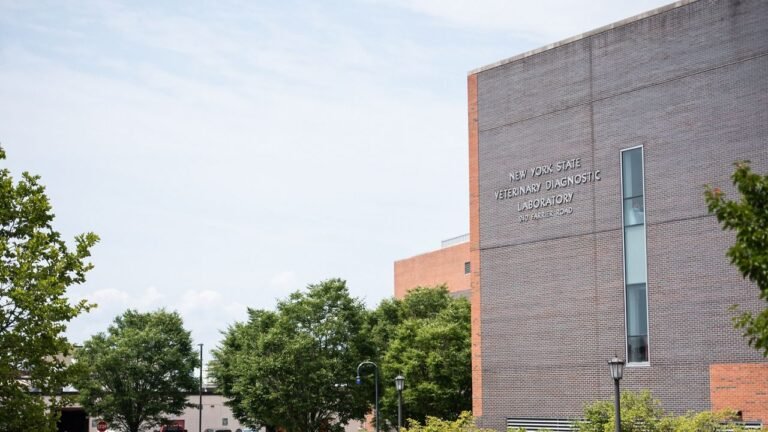While there have been no confirmed cases of avian flu among dairy cows in New York, Cornell University researchers will be using state funding on the front lines to help fight the outbreak.
The New York State Legislature approved $19.5 million for the expansion of Cornell University’s Animal Health Diagnostic Center on Monday, just months after it was confirmed that avian influenza was spreading among dairy cows.
“There was a clear need to expand this facility so that we could now address HPAI and all other needs,” New York State Agriculture Commissioner Richard Ball said.
In March, a dairy herd in Texas tested positive for highly pathogenic avian influenza, confirmed by the Animal Health Diagnostic Center.
“We have to think about this new phenomenon of HPAI infections in dairy herds, which we thought was limited to the poultry industry. There is a real need and demand for diagnostic labs to help us understand it.” [is important]” said Ball.
While New York State has not reported any positive cases of HPAI in dairy cows, 13 other states have, which has concerned the commissioners.
“Any dairy cows that move interstate have to be tested before they move so we’re watching that very closely. We’re very focused on biosecurity in the dairy industry,” Mr Ball said.
Pasteurization of milk is essential to kill viruses in milk.
“We’ve tested nationally and statewide multiple times, people here have done a lot of testing so we’re OK, we have a safe milk supply, but we still need to understand more about how this is spreading,” Ball said.
Diego Diel, director of the Virology Laboratory at the Animal Health Diagnostic Center, was one of the first researchers to confirm mammal-to-mammal transmission of highly pathogenic avian influenza after receiving milk samples from a farm in Texas.
“When the samples arrived, we initially tested them for the usual targeted pathogens that cause respiratory disease in cattle, but all the sequences came back negative. We then decided to perform next-generation sequencing on these samples, which is how we detected the avian influenza sequences,” Diehl said.
Researchers don’t know exactly how the virus spreads from cow to cow, but Deal thinks it may spread through aerosols produced during the milking process, because cows shed large amounts of the virus in their milk.
“That’s one way influenza can be transmitted. Another possibility is mechanical transmission through milking,” Deal said.
After an infected cow is milked, the milking machine moves on to the next cow, who can then spread the infection, resulting in reduced milk production. Deal said that to his knowledge, there have been no confirmed cases of the disease in beef cattle.
“I think it’s probably less likely to be transmitted because the virus has a tropism for the mammary gland. Dairy cows are susceptible and could transmit the virus, but I think that difference limits transmission,” Deal said.
His research has found that pet cats and raccoons have also tested positive for the virus.
In New York State, dairy cows attending county and state fairs are required to test negative for HPAI within seven days, and many of these tests are performed at Animal Health Diagnostic Centers.
“Let’s not make things worse,” Ball said. “That’s completely understandable, and several states have the same policy.”
There are also restrictions on poultry exhibited at the fair; while cattle can survive highly pathogenic avian influenza, birds cannot.
“It’s a big deal for the cattle but for poultry it’s a matter of life and death and the only solution is culling,” Mr Ball said.


